 If you’ve read even a few of my posts, then you know I focus pretty consistently on an issue that lurks, quietly but dangerously, waiting to sabotage our best efforts to achieve improved organizational outcomes through improved workforce performance. The villain of this piece is the sloppy, inconsistent, ill-defined and rampant misuse of terminology. The English major/natural science minor within me screams every time I hear or read someone misuse the subjunctive. But my psyche screams even louder when colleagues who should know better use talent management or engagement or SaaS or analytics to describe whatever ill-conceived or outdated idea or product they’ve got on offer this week.
If you’ve read even a few of my posts, then you know I focus pretty consistently on an issue that lurks, quietly but dangerously, waiting to sabotage our best efforts to achieve improved organizational outcomes through improved workforce performance. The villain of this piece is the sloppy, inconsistent, ill-defined and rampant misuse of terminology. The English major/natural science minor within me screams every time I hear or read someone misuse the subjunctive. But my psyche screams even louder when colleagues who should know better use talent management or engagement or SaaS or analytics to describe whatever ill-conceived or outdated idea or product they’ve got on offer this week.
But where to start to save humankind from sloppy terminology? The colloquial vocabulary for many to most of the important concepts at the intersection of the domain (formerly known as?) human resource management (HRM) and the domain (still widely known as!) information technology (IT) is so imprecise that I could make myself and you totally crazy trying to unravel that muddle. No entirely sane person is going to read the 3,000+ pages it has taken me to do so in my magnum opus, although a really surprising number of you — and you know who you are — have already done so or are doing so as I write, and I thank every single one of you.
When I began blogging, WAY back in November, 2009, I thought that the best place to start, to rid my world once and for all of sloppy, or worse, agenda-riddled terminology, was, as always, to begin with the results we’re trying to achieve, working backwards from business outcomes to figure what must get done, how, when and by whom, in order to achieve those results. In my professional life, the results we’re trying to achieve are specific organizational outcomes through what we used to call effective human resource management (HRM). But now, with the introduction of autonomous, even general purpose (or at least broad purpose) robots into the workforce, we simply must find a new term to describe the management of a workforce that not only includes employees and contingent workers of all flavors but also those darn robots.
I’ve used HRM (HCM being a much more recent and talent management-oriented term) since about 1980 to describe the subject matter domain, HR to describe the function, HRMS to describe the collection of software (ideally, truly integrated) which automates the bulk of administrative HRM while creating the essential foundation for TM, talent management (a much newer term). Given the always critical importance of integration across HRMS and TM, I have also used HRMS/TM to describe that integrated core suite which is central to effective HRM at every organization.
For me (and it’s central to every annual release of my HRM Business Model “Starter Kit” since 1995), the workforce has always included both employee and non-employee workers of every type, schedule and duration, and the HRMS/TM should always have addressed the entire workforce. But now, with humanoid robots entering the workforce, HRM etc. aren’t big enough terms to cover what’s really work and workforce management.
I’d like to change our collective vocabulary from HRM to WFM (workforce management), but that abbreviation has been in long use to describe the functions and software that manage scheduling, time and attendance, and related processes. Could I repurpose WFM to a much broader use? Probably not given the marketing $$ committed to its traditional meaning. So what’s a language precisionist supposed to do?
Work and workforce still apply as long as we consider workers to be both human (so employee and non-employee or contingent workers) and non-human (so humanoid robots, which could be acquired, maintained and accounted for as plant and equipment but to which many of the work and workforce-related processes (e.g. scheduling, development and onboarding as well as off-boarding) and object model (e.g. robots must have one to many KSAOCs and have their work defined in terms of duties and responsibilities) can be applied). No, I haven’t gone off the rails. We clearly need real care with our vocabulary as we expand greatly the notion of worker, and I’d really like to use WFM for this purpose.
The HR community was VERY slow to address properly, to include within the HRMS/TM, contingent workers in all their flavors, and we can’t miss the boat on robotic workers. Since vocabulary shapes thinking, as anyone who’s studied multiple languages knows, we’ve no time to lose in straightening out our vocabulary for the extended definition of workforce and for the related management processes. But, in the absence of a better term, I’m going to use worker management (WM). Therefore:
WM is a business domain, a collection of processes and business rules whose purpose is to help ensure long-term business and organizational success. WM is about planning for, organizing, acquiring, deploying, assessing, rewarding, leading, coaching, supporting, informing, equipping, retaining, and developing a high performance, cost-effective workforce. It is also about nurturing the growth, usage and value of the organization’s intellectual capital and personal networks.
What a mouth full, and there’s more. WM isn’t just the work of a central/local/3rd party WM department. While a WM department and WM professionals may still control the strategy and design of WM, WM execution is increasingly in the hands of managers and leaders (who may themselves be non-employee workers and/or robots) at every level and the increasingly technology-enabled, self-sufficient workforce.
The bottom line? The purpose — the expected organizational results — of WM are to maximize the performance of the organization’s workforce and the leverage from its intellectual capital and personal networks toward achieving the organization’s stated business outcomes. If we could get all of the organization’s work done and results achieved without any workforce, we wouldn’t need WM. But we can’t, at least not yet, so we do.






Interestingly if there is no ‘workforce’ then there are no leaders either. Bricks and mortar don’t speak for themselves- robots or no robots. Those who do speak for the bricks and mortar ‘entities’ called organizations cannot simply ‘maximize the performance….” out of context of the stakeholders’ needs who are also ‘in’ that workforce. To me this is the same circular ‘graduate student debate’ and discussion first started by F.W. Taylor, author of Principles of Scientific Management published in 1911. Some seriously missing phrases in the definition need further enhancement. What am I missing Naomi?
I’m not sure I’m following the gist of your comment, but I welcome it and any specific suggestions you’d like to make as to the definitions. Many thanks.